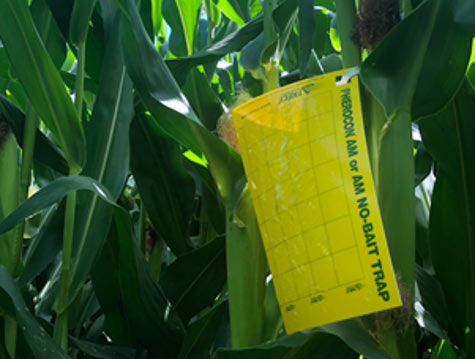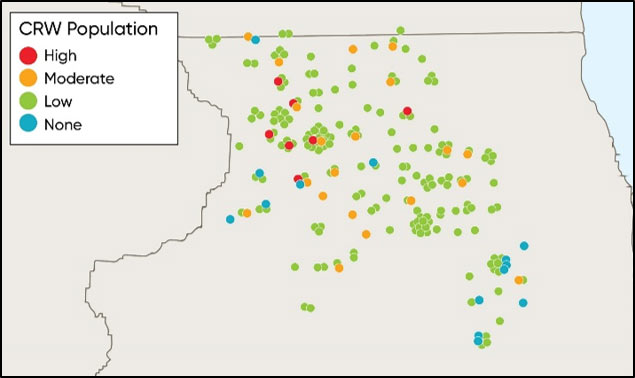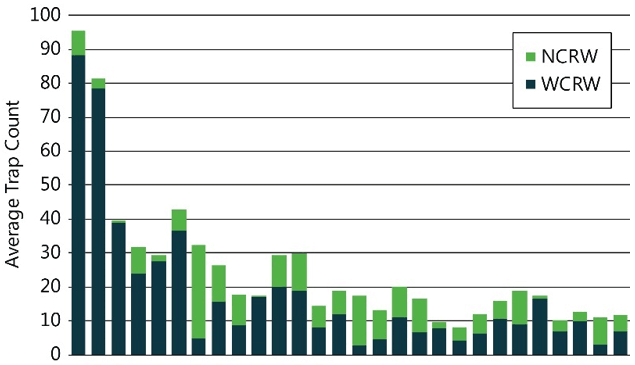Objectives
- Quantify the western and northern corn rootworm beetle populations across northern Illinois with Pherocon® AM/NB sticky traps.
- Understand how modern management practices influence corn rootworm population levels.
- Identify best management practices for growers to make informed decisions for the following growing seasons.
Study Description
- Year: 2019
- Locations: 210 field locations across Northern Illinois
- Sampling Methods:
- Sticky traps placed in fields starting at blister stage (R2)
- Sticky traps placed per field: 6
- Northern and western corn rootworm beetles were counted every seven days and average counts per trap were recorded.
- Trapping continued for 5 consecutive weeks by Pioneer Sales Professionals and Pioneer Agronomists.
- Trapping was conducted in fields managed in the following rotations:
- Continuous corn fields
- Corn following soybean fields
- Soybean following corn fields
- Planting Dates Assessed:
- Northern Illinois experienced very challenging planting conditions in 2019, so fields included in the study were planted over a much greater range of dates than normal.
- Location planting dates were spread across April, May, and June.
- Foliar Insecticide Treatment:
- 28 locations included a foliar insecticide treatment.
- Treatments were made with an aerial fungicide applicator and were made at blister stage (R2).
- Proper safety and reentry interval protocol was followed by individuals collecting beetle counts.

Figure 1. A new Pherocon® AM/NB sticky trap set in a corn field near Mount Morris, Illinois. Trapping extended for 5 consecutive weeks, with traps replaced and beetles counted every week.
Results
- Corn rootworm populations were characterized at four different levels for each sampling location:
- Zero = no beetles collected
- Low = <21 beetles/week
- Moderate = traps averaged 21-50 beetles/week
- High = traps averaged >50 beetles/week
- Peak corn rootworm beetle population levels observed at sampled fields across testing period (Figure 2):
- 6.7% of fields had zero adults collected
- 80% of fields had low populations
- 10% of fields had moderate populations
- 3.3% of fields had high populations

Figure 2. Peak population levels observed at corn rootworm beetle trapping locations in 2019.
- Western corn rootworm and northern corn rootworm species compositions varied at locations depending on population levels (Figure 3).
- High population locations largely consisted of western corn rootworms at an average of 85 percent.
- Moderate population locations had a more even mix of species, with western corn rootworm averaging 60 percent and northern corn rootworm averaging 40 percent.

Figure 3. Species compositions for high and moderate population locations across Northern Illinois in 2019.
- Planting date influenced the dates of peak trap count timing (Table 1).
- Corn rootworm populations peaked a week later in June-planted locations than in those planted in April or May.
- Across all moderate and high population locations, the average date of peak corn rootworm beetle populations was August 22, 2019.
Table 1. Among the untreated locations, peak population counts had different timings with each planting window in 2019.

- Crop rotation affected CRW pressure levels (Table 2).
- 100 percent of the high pressure locations and 85 percent of the moderate pressure locations were planted to corn following corn.
- All corn following soybean locations except one had low or zero corn rootworm populations.
Table 2. Distribution of pressure levels based on crop rotation.

Action Thresholds
- If traps average <21 beetles per week:
- Low rootworm populations are anticipated next year
- Select a control option for each field:
- Rotate acres to another crop
- Plant a corn rootworm Bt corn product
- Plant a non-Bt rootworm product with Poncho® 1250/VOTiVO® insecticide treatment
- Plant non-Bt rootworm product with soil insecticide for larvae
- If traps average 21-50 beetles per week:
- Moderate rootworm populations are anticipated next year
- Select a control option for each field:
- Rotate acres to another crop
- Plant a corn rootworm Bt corn product
- Apply a soil insecticide at planting for larvae
- If traps average >50 beetles per week:
- High rootworm populations are anticipated next year
- Select a control option for high populations:
- Rotate acres to another crop
- Apply foliar insecticide in the current year to control adult beetles prior to egg-laying and use a corn rootworm Bt corn product or soil-applied insecticide the following year.
Management Considerations
- Studies have shown that the HXRW trait remains an effective tool for corn rootworm management, but Pioneer and university research suggests that continuous, uninterrupted use of the same corn rootworm Bt technology can lead to reduced product efficacy against these insects.
- To maintain efficacy of Bt corn rootworm products, it is essential to develop a rootworm management plan that:
- Breaks the cycle
- Manages populations
- Protects the Bt trait
- Please contact your Pioneer Sales Professional or local Extension professionals to assist you in developing field-specific best management practices for your operation.

Poncho® and VOTiVO® are registered trademarks of Bayer.
The foregoing is provided for informational use only. Please contact your Pioneer sales professional for information and suggestions specific to your operation. 2019 data are based on average of all comparisons made in 210 locations through September 24, 2019. Multi-year and multi-location is a better predictor of future performance. Do not use these or any other data from a limited number of trials as a significant factor in product selection. Product responses are variable and subject to a variety of environmental, disease, and pest pressures. Individual results may vary.
Author: Crystal Dau
October 2019